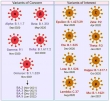Next-Generation Vaccines Against COVID-19 Variants: Beyond the Spike Protein
Abstract
Vaccines are among the most effective medical countermeasures against infectious diseases. The current Coronavirus disease 2019 (COVID-19) pandemic, caused by severe acute respiratory syndrome coronavirus 2 (SARS-CoV-2), has spurred the scientific strategies to fight against the disease. Since 2020, a great number of vaccines based on different platforms have been in development in response to the pandemic, among which mRNA, adenoviral vector, and subunit vaccines have been clinically approved for use in humans. These first-generation COVID-19 vaccines largely target the viral spike (S) protein and aim for eliciting potent neutralizing antibodies. With the emergence of SARS-CoV-2 variants, especially the highly transmissible Omicron strains, the S-based vaccine strategies have been faced constant challenges due to strong immune escape by the variants. The coronavirus nucleocapsid (N) is one of the viral proteins that induces strong T-cell immunity and is more conserved across different SARS-CoV-2 variants. Inclusion of N in the development of COVID-19 vaccines has been reported. Here, we briefly reviewed and discussed COVID-19 disease, current S-based vaccine strategies, and focused on the immunobiology of N protein in SARS-CoV-2 host immunity, as well as the next-generation vaccine strategies involving N protein, to combat current and emerging SARS-CoV-2 variants.


